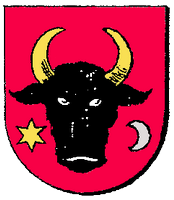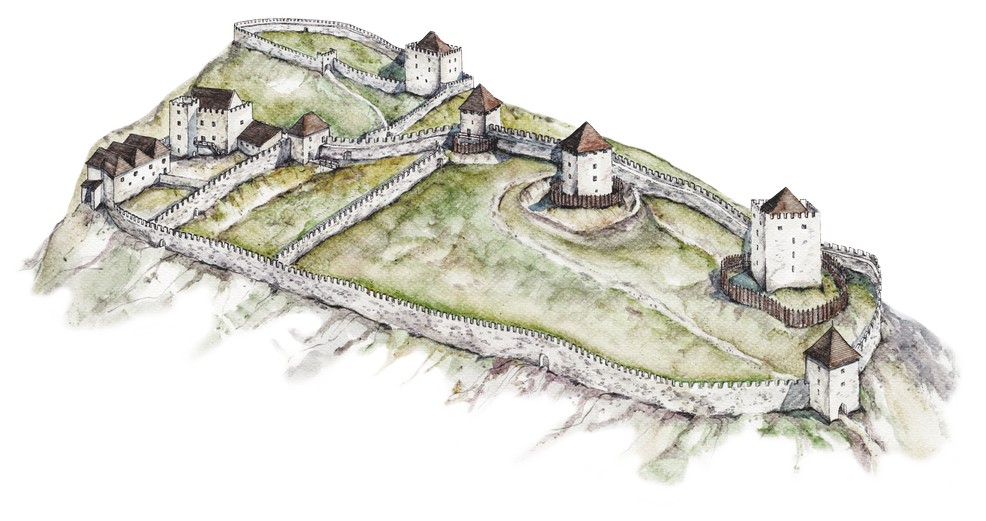HUNGARIAN FAMILY OF BALASSA AT MODRÝ KAMEŇ CASTLE | ||
 | ||
The significant and branched genus of Balaša have left a deep footprint in the history of the Kingdom of Hungary. They held prominent positions close to the monarchs, achieved significant successes on the battlefields and were actively engaged in science and literature. Many prominent politicians, soldiers and writers of that name have already been forgotten, information on their legacy in Slovakia is fragmentary and seldom published. Undoubtedly, one of the reason for that is that no residence of the family with original furniture and artworks has been preserved. The Balašas left the stage of history gradually, either due to the loss of property or to the extinction of the family branches by the sword. The small town of Modrý Kameň with a rare monumental area left behind by the Balašas from Ďarmoty and Modrý Kameň, has preserved the name of the hereditary lords of the castle in the memory of generations for centuries. The Modrý Kameň castle stands on a castle hill above the town and, as the Balašas decided to build a Renaissance-Baroque mansion on the preserved remains of the original gothic castle, a unique historical edifice stands there today. Architecturally, the manor is connected to torsional architecture, which, in fact, creates a historical garden offering a unique view of the nearby Southern Slovak Basin and the plains of the Hungarian borderline belonging to the historical County of Novohrad, from where the fatal enemy – the army of the Sultan of the Ottoman Empire Suleiman II – approached the castle. However, the eventful history of the castle in the Kingdom of Hungary was not only written by the Ottomans. The turbulent power ambitions of the monarch, nobility, clergy and other layers of society, lack of unity in action against the enemy and their own interests fundamentally influenced the fate of this fortresses. Modrý Kameň is one of the few castles of the Balašas in Slovakia, which has been preserved in its original form as it was under the generations of the family, which had lived there for more than 600 years until the last decades of the 19th century. | ||
ANCESTORS OF THE BALAŠA FAMILY AS THE GOVERNORS OF ZVOLEN | ||
They stood at the establishment of the Zvolen County and held the position of its governors (ispán) since the establishment of this office in 1222 till the middle of the 14th century, i.e. for 120 years, until the extinction of the county, when one of the most significant ancestors of the Balassa family Magister Knight Donč completed his office as the last governor of the county. The Zvolen County covered a large area of Zvolen and its vicinity as well as the regions of Turiec, Liptov and Orava. Because of the large forests in its territory, it was also called LESNÁ (i. e. the forest-county).The first known governor of the county DETRIK (also called “the great”), son of Synko, and the oldest known ancestor of the genus of Balaša, was a recognized and privileged man in the service of King Andrew II of Hungary. As a “homo regius” (i.e. a royal man), he was authorised to execute royal orders in the field of law. His career opened the way for his descendants. His son Miko served as an governor of the county in 1246 – 1252. His descendants established the genus of Balassa. His sons Michal, Detrik and Peter also took turns as governors of the Zvolen County. In 1267, the last of them, Peter, is mentioned as the holder of the Modrý Kameň castle. Detrik’s son Biter was also a Zvolen County governor (1277 – 1282). One of the most important Zvolen County governors, with high competences of the County Judge and the Chief Royal Official given by King Bela IV of Hungary, was Demeter. He contributed to strength henroyal power by participating in many major battles during the reign of King Andrew III of Hungary. He commanded the Hungarian army, belonged to the king’s circle and to the most influential barons of the country. He died at the battle of Rozhanovce (1312) as a supporter of the oligarch Matthew Csák (1260 – 1320). His nephew Magister Knight Donč achieved a similar status as the Zvolen County governor in 1314 and 1317, but rather as a diplomat. | ||
 | ||
Zvolenský (Pustý) hrad – residence of governors Zvolen (forest) county. Ideological Reconstruction, drawing by Michal Šimkovic a Iveta Chovanová | ||
THE NAME OF THE BALAŠA GENUS | ||
In the middle ages, the genus split into several branches. The branch “from ĎARMOTY” took most of the credit for the success, wealth and social status of the family. After the offspring of Donč died out, the direct followers of the genus were Miko’s sons Biter and Peter (Forró), who owned the castle and the manor of Modrý Kameň located in the centre of their possessions (before 1278). They acquired possessions between the Novohrad and Šariš Counties and managed many royal estates. BALÁŽ FROM ĎARMOTY (1364 – 1388), the great-grandson of Biter was, during the reign of the House of Anjou (1301 – 1387) and the reign of King Sigismund of Luxembourg (1387 – 1437), a vice-governor of Rábakőz and castellan at the Royal Castle of Kapa in the Šopron County. He provided the genus with a single descendant for the 4th generation – Mikuláš.MIKULÁŠ, SON OF BALÁŽ - Governor of Novohrad and Hont Counties (1435 – 1436), had two sons, Ladislav and Žigmund. Ladislav achieved, in the service of Queen Elizabeth of Luxembourg (1409 – 1442) and later John Hunyady (1446 – 1452), a significant social status. During the reign of King Matthias of Hungary (1458 – 1490), he was a member of the group of the most loyal nobles; it was at a time, when the reign of the king was at risk from a conspiracy by hostile local nobility. The oath of allegiance to the king (1459) includes the name of Ladislav - son of Baláž from Ďarmoty (in fact, his grandson). His brother Žigmund also used the name “son of Baláž” (in Hungarian there is a paternal suffix-Balázs-fia or Balázs-fi). Their descendants were called “sons of Baláž”, later BALAŠA. In the late Middle Ages, during the reign of King Matthias of Hungary in the middle of the 15th century, the generic name Balassa became permanent. | ||
FRANTIŠEK I. BALAŠA FROM ĎARMOTY (1471 – 1526) | ||
 | ||
Ladislav’s oldest son František, the first holder of the name BALAŠA, took advantage of the historical status of the family: long-term service in the county and the court and the ownership of the manor and castle of Modrý Kameň. His beneficial marriages also helped him to become an increasingly important political owner of the territory north of the Danube. He strengthened the position of the family in the privileged social layer of the time under the reign of the Jagiellonian dynasty. His successful military career brought him the title of one of the most important leaders of the anti- Ottoman defence, Captain of the Royal Light Cavalry, and his diplomatic and court service a title of “decempersona” awarded to the 10 most important courtiers at the Royal Court. In 1505, he gained the title of baron, and shortly after also the rank of the southern Ban. In 1512 he obtained the castle of Divín. From 1517 till his death, he was a governor of Novohrad Country. The growth of his political influence was ended by the Battle of Mohacs against the Ottomans (1526), where he died along with King Louis II of Hungary and the elite of the country’s nobility and church, who perished on the battlefield. His death ended the medieval history of the genus of Balaša. In the new era of Ottoman domination, however, they became the founders of the anti - Ottoman defence. | ||
MELICHAR BALAŠA (1511 – 1568) | ||
 | ||
The son of Franišek Balaša from his second marriage with Uršula Peréniová, brother of Ján Balaša. The owner of the castles of Divín, Hajnáčka, Levice, Čabraď and Sitno, governor of Hont and Tekov County. In 1561, he was promoted by Ferdinand I to the status of baron. Hero of the battles against Ottomans and a thievish knight. His nature as a violent and cruel man was the basis for many stories and legends about his deeds. Since the historic battle against the Ottomans in Levice (1544), the town’s gate has been called Balaša’s Gate, because following his victory, he chased the enemy out of the town through this gate. He is buried in Sološnica in the Church of All Saints below the Plaveč Castle. | ||
Go to content
Back to content


